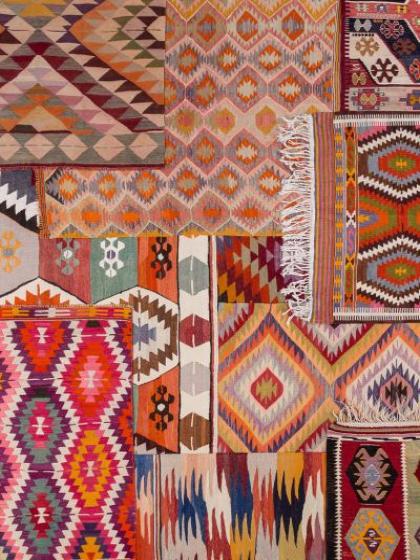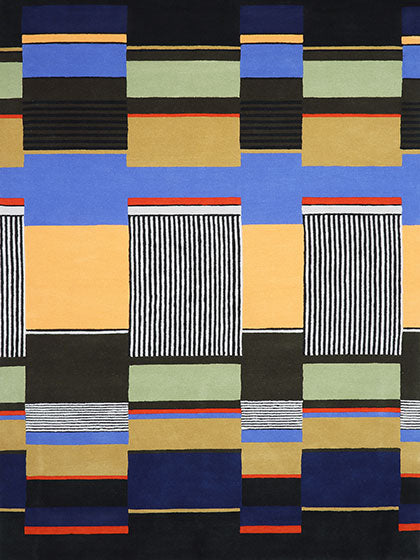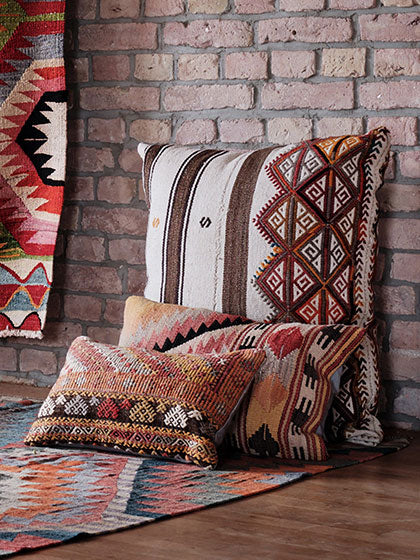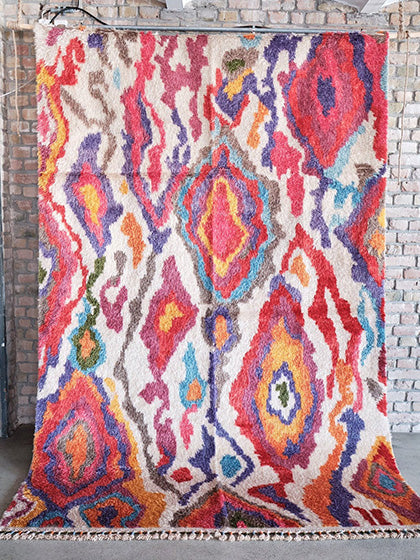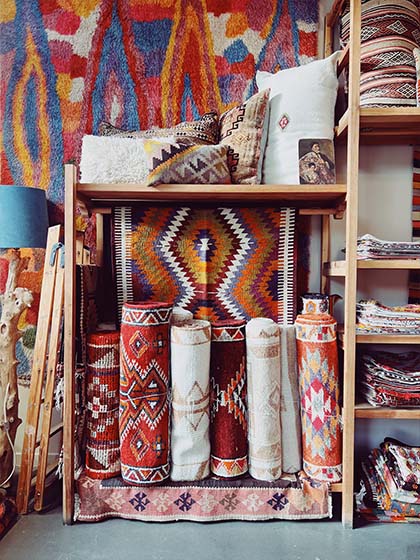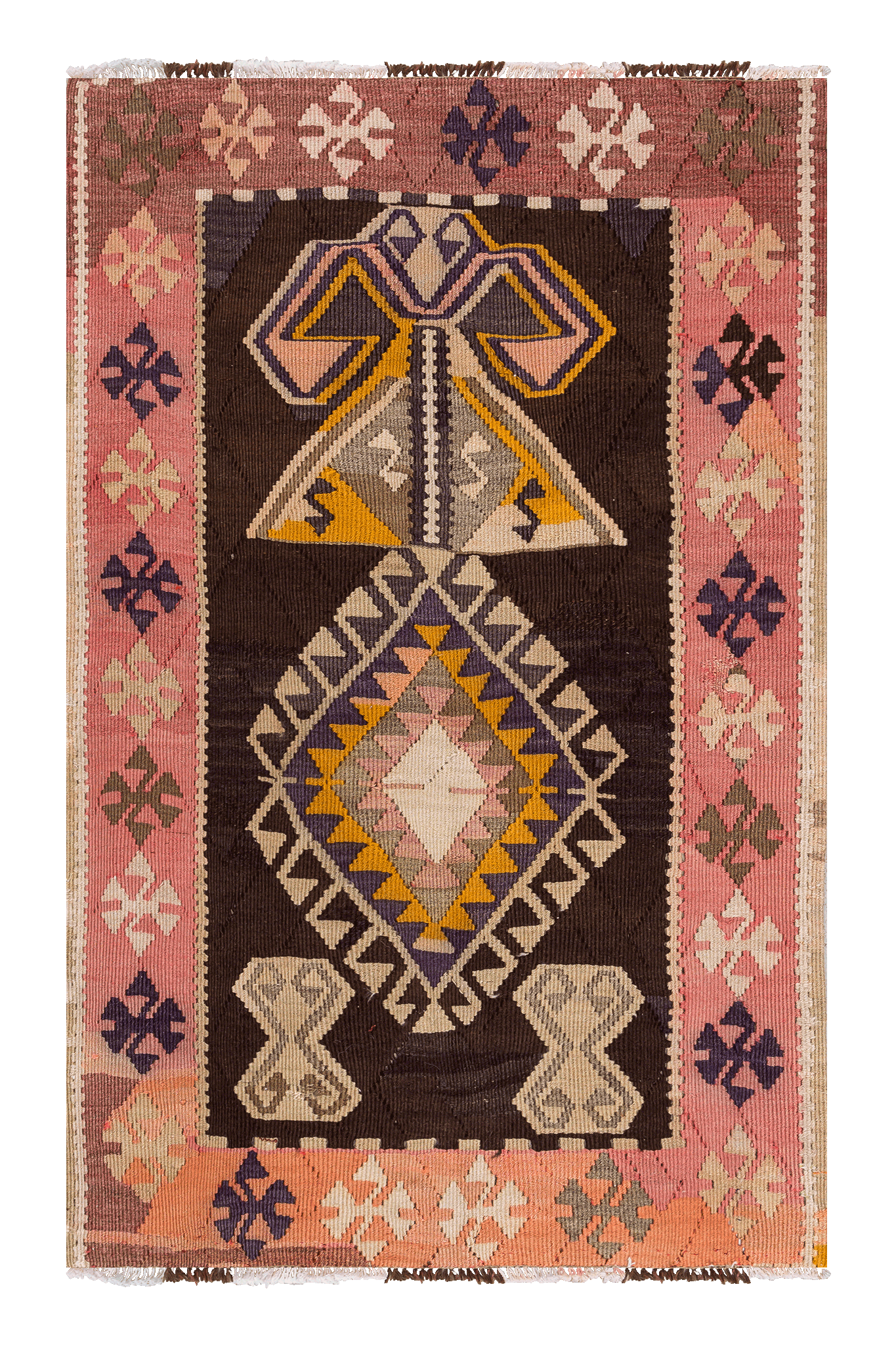
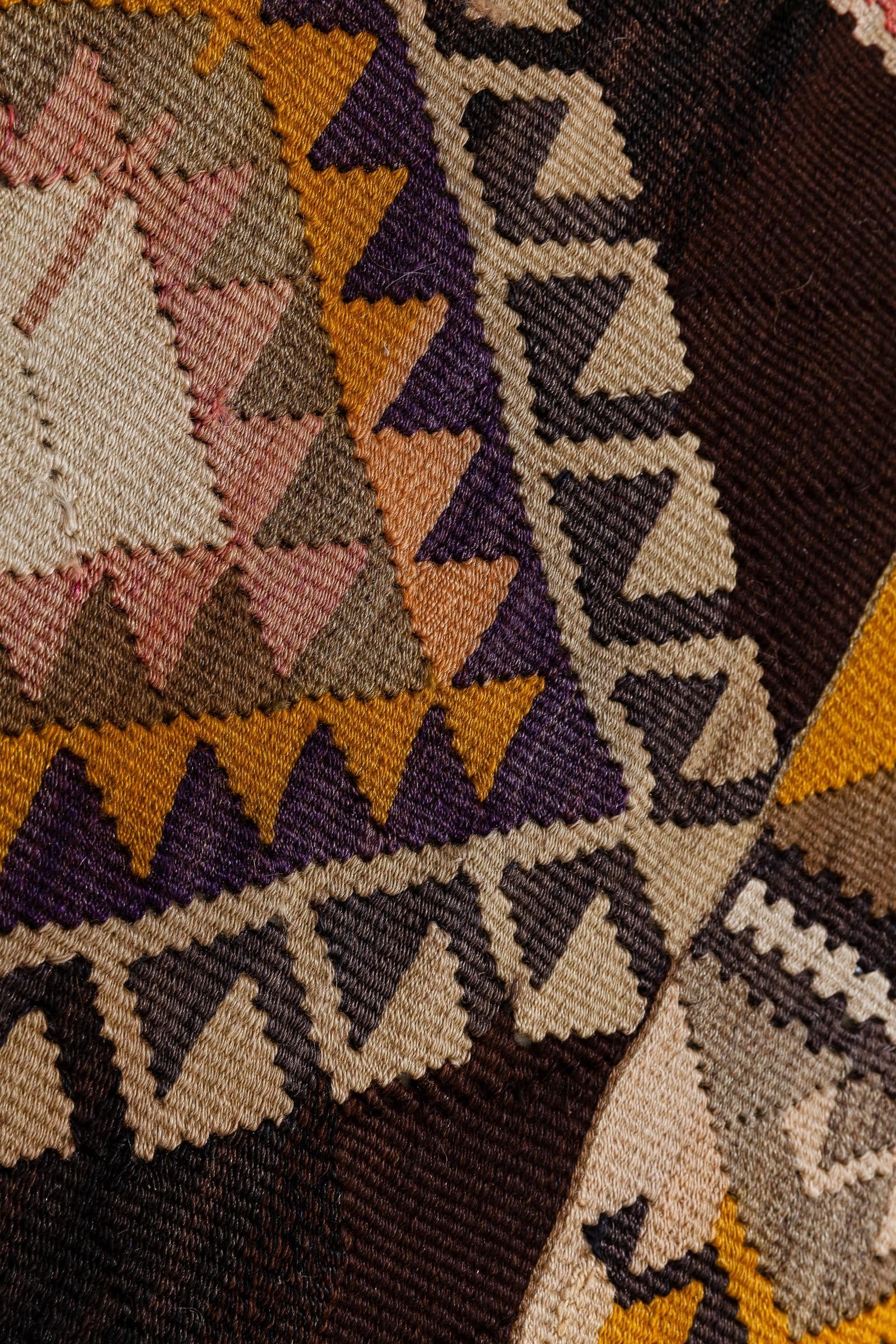
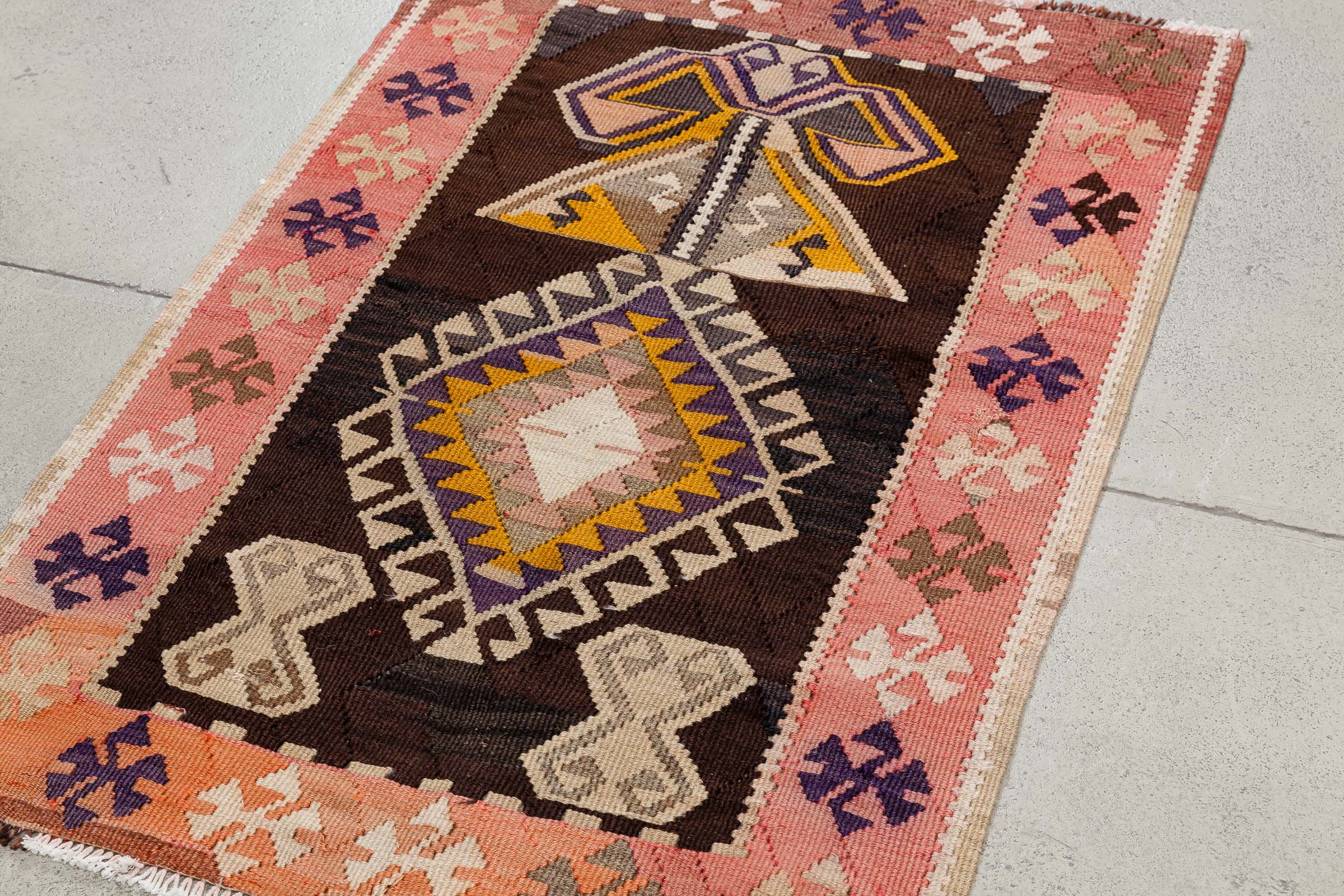
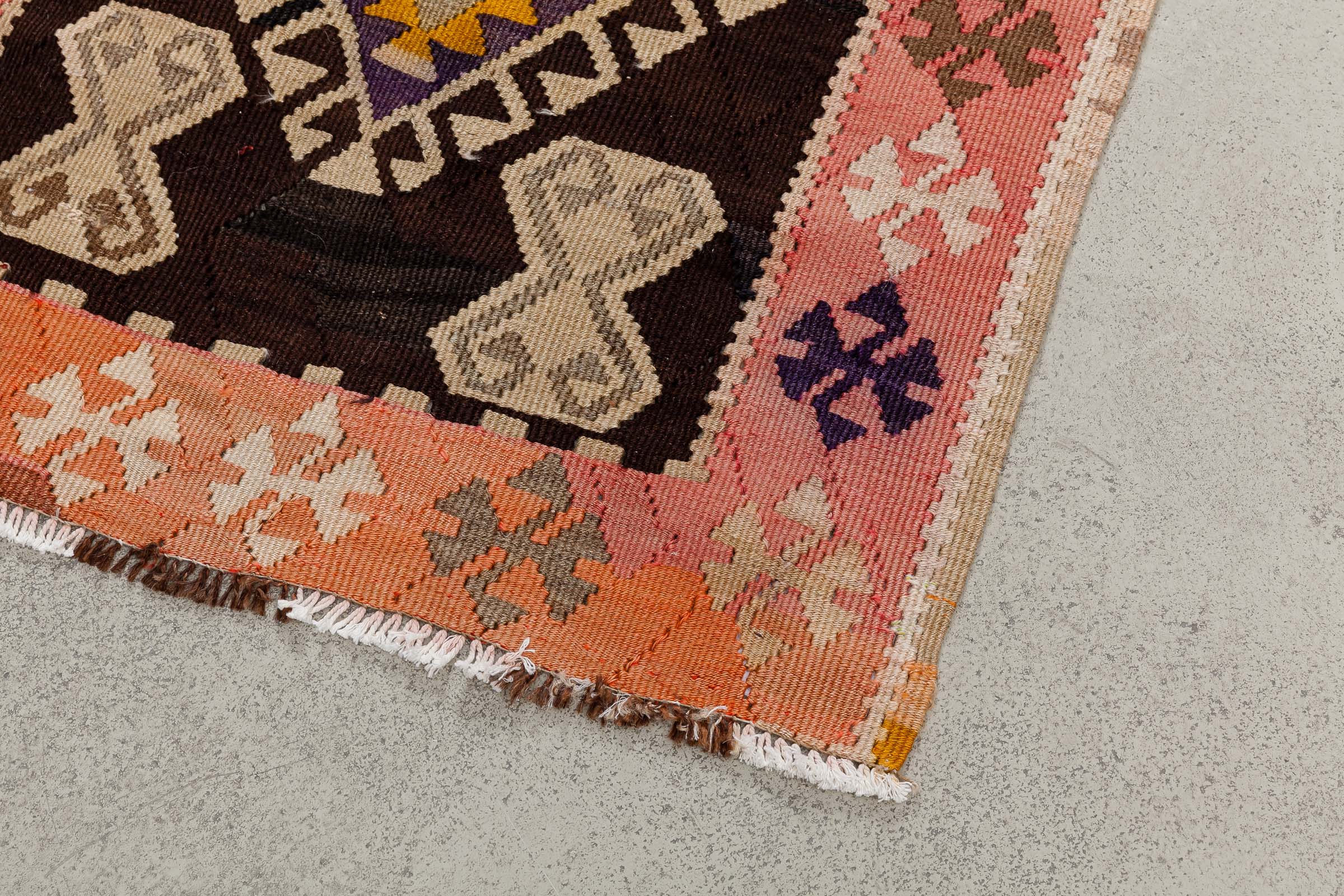
KARS Vintage Kilim 115x72cm
KARS Vintage Kilim 115x72cm
Wild Heart Free Soul
Kastanienallee 55
10119 Berlin
Germany
Proud symbolism from northeastern Anatolia
This handwoven vintage kilim comes from the Kars region—a rugged, high-altitude region in northeastern Anatolia. Crafted in the 1960s, it speaks of strong hands, clear minds, and the need for protection and expression. The sheep's wool from this cold region is particularly rich in lanolin—which gives the fabric its natural luster, resilience, and a tangible sense of depth.
Symbolism in clear geometry
At the center of this unique piece is Elibelinde —the symbol of feminine power. Hands at her waist, upright, alert—she embodies fertility, trust, and creative power. Two other Elibelinde motifs flank the center, like reflections of inner strength. The composition is complemented by other archaic symbols:
- Çengel (double hook): connection of opposites – balance and support
- Kurt İzi (Wolfsspur): Alertness and inner clarity
- Göz (Eye): Protection from evil, perception and consciousness
- Bukağı (bond): connection, responsibility, bond to life
Each of these symbols was woven not decoratively, but meaningfully – as a silent prayer, as a woven memory, as a protective formula.
Colors with character
Typical of the Kars region, rich, contrasting tones unfold: dark brown, like fertile earth, flanked by rose, lilac, warm yellow, and dusky pink. This color scheme appears both archaic and modern—and powerfully highlights the symbols in its clarity.
For sacred places in everyday life
With its compact dimensions, this kilim is ideal as a meditation space, wall hanging, or as a quiet companion in the bedroom. It opens spaces for contemplation, intuition, and connection—whether as a powerful ritual piece or as a quiet work of art in everyday life.
Gently restored & sun-clean
Like all our pieces, this kilim has been carefully restored and cleaned with olive soap and sunlight —a process that revitalizes the fabric without erasing its history.
A kilim from Wild Heart Free Soul is not a product.
He is an inheritance. A woven wish.
And perhaps a companion for your home of tomorrow.
Choose options
Anatolian, flat-woven kilim rug made from hand-spun sheep's wool. Vintage unique item with collector value!
Selected by Wild Heart Free Soul to the highest quality standards, naturally cleaned and professionally restored.
Age-related patina and natural irregularities are characteristic of our handmade vintage rugs.
- Material: 100% hand-spun sheep's wool, highest quality
- Processing: Flatwoven by hand on a traditional, horizontal wooden loom
- Age: Semi-Antique. Circa 1960-1970
- Condition: Vintage in mint quality thanks to an extensive cleaning and restoration process
- Origin: Kars
- Size: 115x 72cm, height: 3mm
- Weight:
Anatolian kilims are far more than mere textile objects – they are woven memories, personal messages, and expressions of living culture. For generations, women from nomadic tribes and villages wove their wishes, hopes, and stories into the fabric – freely, intuitively, and full of symbolic power.
This kilim, too, was woven in an Anatolian home—from the wool of the home's own sheep, sheared, washed, combed, and spun by hand. The yarns were often dyed with natural pigments such as madder, mignonette, walnut, or indigo—but from the 1950s onward, synthetic dyes increasingly found their way into the villages. The world became faster, more colorful—not every kilim remained purely plant-dyed. Many pieces from the 1960s and 1970s bear the traces of a cultural transition in their tones: between old and new, craftsmanship and modernity.
Weaving was a ritual act – accompanied by songs, stories, and silence. Often, several women sat together at the loom: mother, grandmother, sister, neighbor. Every knot, every line, every symbol carried meaning – protection, fertility, connection, power. Symbols such as the eye ( Göz ), the cosmic mother ( Elibelinde ), and the scorpion became carriers of profound messages.
They were used, loved, passed on – and some of them slept in chests for a long time until one day they came to light again.
Today, we clean and restore these pieces with the utmost respect: washed with olive soap, dried in the Antalya sun, and repaired in our Istanbul studio.
Some pieces are with us for only a few months, others stay with us for years – because we don't rush into anything. Each kilim is restored with time, care, and respect. Some wait for the right restorer, for the summer months to bathe in sunlight – for their quiet retransformation into a living work of art.
A kilim from Wild Heart Free Soul is not a product.
He is an inheritance. A woven wish.
And perhaps a companion for your home of tomorrow.
A kilim is a long-lasting companion—if treated with love and cared for carefully, it can last for many generations to come. It doesn't require extensive care, but rather the right kind.
We recommend gently vacuuming or beating the kilim once or twice a month to remove dust and dirt. Please do not use a rotary vacuum cleaner for this purpose; ideally, use a brush attachment or a gentle handheld device. Too frequent, intensive vacuuming can wear out the fibers over time.
Every few months, it's worth turning the kilim over and vacuuming the back as well. Rotating the rug slightly once a year ensures even wear and maintains the balance of the weave.
For basic cleaning, we recommend a professional hand wash every 3 to 5 years – using a pH-neutral shampoo or olive soap, gently worked in by hand, and thoroughly rinsed. Please never dry or steam clean your kilim – this will damage the fibers. If you need assistance choosing a suitable cleaner, we'd be happy to advise you. We work with experienced oriental rug specialists and are happy to share our special rates.
And if an accident does occur: Immediately dab fresh stains with a clean, dry cloth. If necessary, gently dab with a little olive soap and a slightly damp cloth – without rubbing or soaking. For stubborn stains, please consult a specialist immediately. Liquids that spread along the fibers can become permanently trapped, especially in flat weaves.
Dried food residue can usually be carefully scraped or brushed off – ideally with a steady hand and without haste.

